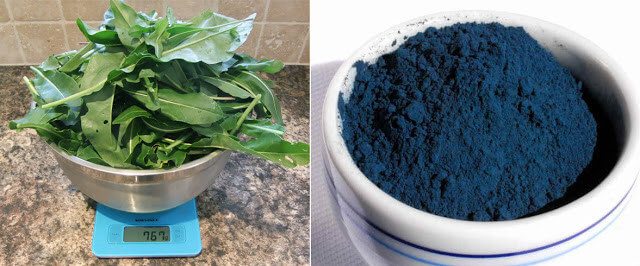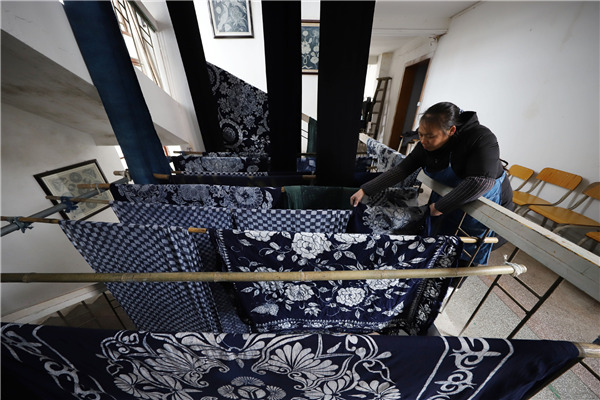
From the People's Daily App.
This is Story in the Story.
The leaves of a traditional Chinese herb have become an integral ingredient for a promotional campaign on the distinctive ethnic culture of Southwest China's Guizhou Province.
Locals traditionally wear dark blue ethnic clothes featuring pictures with Miao elements.
Wax dyeing for Miao ethnic clothes has surged in popularity. Small companies engaged in rhizoma plantation and wax dyeing have helped alleviate poverty in the region.
"These days, people have more demand for plant-based pigment, and some big textile companies are using the indigo pigment,” said one business owner when discussing the emergence of wax dyeing.
The niche garment industry has generated jobs for the locals and has helped lift over 2,800 farmers out of poverty.
"Plant-based pigment is environmentally-friendly. It not only meets people's demand but also helps promote Miao ethnic culture other people,” said another business owner.
Today’s Story in the Story looks at how one ethnic community has turned traditional herbal tea leaves into a revenue source and a pathway out of poverty.

Pigments extracted from plants. (Photo: Agency)
Zhang Yiqiong's studio is full of indigo linen fabrics waving in the wind. The cloth materials are wax dyed with the help of the leaves of rhizoma, the Chinese herb believed to have the effect of driving away epidemics and killing insects.
"The root of the herb has a medicinal effect, and its leaves can be transformed into pigment for dark blue dyeing, which is perfect for the clothes of the Miao people," Zhang said.
Zhang is a member of the Miao ethnic minority in the ethnic county of Sandu.
Zhang started learning about Miao wax dyeing when she was a little girl. Her role model was her mother.
"The Miao people's ethnic clothes were just so beautiful in my eyes, and I wanted to learn the skill well," she said.
People traditionally grow rhizoma in the county and have always used its leaves as pigment for their garment.
"Extracting the indigo pigment was quite complicated," she said. "You have to grow the plants first." After reaping the plants, Zhang would soak the leaves in water, fetch the blue leaves, extract the indigo essence, and make it into the sediment.
"Wax dyeing also involves several procedures," she said. "First of all, you need to paint the wax on the cloth and soak the cloth material in the indigo pigment. The final product is not complete until you are done with oxidization, removing the wax and washing."
In 1998, Zhang graduated from junior school and left her hometown for better-paying jobs. After three years of a life adrift, she returned to her home county with some earnings and prepared to create a business of her own.
In 2013, Zhang established a Miao clothes processing store, which would evolve into her own company within two years, mainly focusing on Miao wax dyeing.

Was dyeing techniques applied on sheets. (Photo: China Daily)
The products that the company churns out are Miao clothes with ethnic elements, including the phoenix, flowers, birds, and Miao people playing the Lusheng, a reed-pipe wind musical instrument.
The company has 260 employees for wax dyeing and embroidering. It has cooperated with local farmers in the planting of rhizoma. Last year, locals planted 933 hectares of the herb.
"I have done the wax dyeing work for a long time here," said employee Wei Liyun. "I enjoy the skill, and I am good at it."
We can make $564 a month for her work. She has even continued to work at home during the coronavirus outbreak.
As her business expanded, Zhang wanted to give her ethnic clothes a more "modern touch" so that "more people will get to know the Miao culture." So, she teamed up with some designers from big cities like Beijing and asked them to help re-design the pictures.
"The ethnic style is unique in itself," said designer Wu Huahui. "The plant-based pigment has no pollution and is quite special, so the wax dyed Miao clothes are quite popular in the market now."
"In the past, our pigment was basically in the form of liquid, which could cost more than 400,000 yuan in transportation fees every year," Zhang said. "Now we have drying and powdering machines, which turn the pigment into powder. It has greatly slashed costs."
(Produced by Nancy Yan Xu, Lance Crayon, Brian Lowe and Da Hang. Music by bensound.com. Text from China Daily.)


